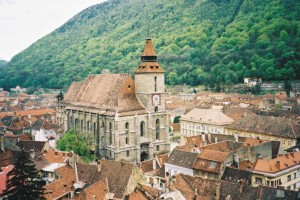Economia
Economia României este caracterizată de stabilitatea preţurilor, stabilitatea financiară şi stabilitatea cursului de schimb valutar raportat la moneda europeană.
Poziţia investiţională internaţională s-a îmbunătăţit, scăzând la un deficit sub 50% din Produsul Intern Brut în martie 2016 (comparativ, nivelul din martie 2015 era de aproximativ –55% din PIB).
Economia română a înregistrat o creştere în 2016, datorită cererii interne, la rândul său impulsionată de politici fiscal-bugetare expansioniste. Comparativ cu anul 2015 când s-a înregistrat o valoare de 3,9%, creşterea PIB-ului real al României în 2016 a fost de 4,9%. Creşterea economică este preconizată la nivelul de 4,4% în 2017 şi 3,7% în 2018.
Investiţiile au revenit la ratele de creştere din perioada anterioară crizei. Creşterea investiţiilor a atins un nivel record de 8,3% în anul 2015. Valoarea totală a investiţiilor (măsurată ca formare brută de capital fix), în anul 2016, a crescut cu 5,5% datorită ratelor scăzute ale dobânzii şi nivelul stabil al încrederii investitorilor. În schimb, în anul 2016, investiţiile publice au scăzut, o cauză fiind ritmul lent de angajare a noilor proiecte de finanţare prin fonduri ale UE pentru perioada 2014-2020.
România are una dintre cele mai ridicate rate ale investiţiilor în UE. În anul 2015 investiţiile totale au reprezentat 24,8% din PIB, peste media UE (de 19,7%).
Inflaţia a scăzut, atingând –3.0% în luna mai 2016. Banca Naţională a României estimează că rata inflaţiei va depăşi 2% la sfârşitul anului 2017, urcând către 3,4% la sfârşitul anului 2018.
Şomajul a scăzut de la 6,8% în 2015 la 6,0% în 2016 şi se apropie de nivelurile minime de dinainte de criză. Au dispărut locuri de muncă în agricultură şi industrie, dar au fost create locuri de muncă în sectorul serviciilor, ceea ce reflectă schimbările din structura economiei.
Deficitul bugetar va creşte în 2017 la aproximativ 3,6% din PIB, iar în 2018 la 3,9% din PIB, rezultate din relaxarea fiscală continuă şi de reducerile de taxe anunţate. Concomitent, nivelul datoriei publice a României va înregistra creşteri de la 38% din PIB în 2015 la 40,5% în 2017 şi 42,3% în 2018.
Consumul este aşteptat să continue să fie principalul generator de creştere economică, în perioada următoare, fiind urmat de investiţii. Datorită cererii interne ridicate, este aşteptată o creştere suplimentară a importurilor, ceea ce va conduce la creşterea deficitului comercial de la –6,2% în 2016 la –7,3% în 2017 şi –7,7% în 2018. În acelaşi timp, exporturile sunt aşteptate să crească, însă la rate mai mici decât importurile, principalul factor fiind creşterea economiei spaţiului european, principala destinaţie a exporturilor româneşti.
(Sursa: Camera de Comerţ şi Industrie a României (http://ccir.ro), Studiul asupra stării mediului economic: http://ccir.ro/wp-content/uploads/2014/11/starea-mediului-economic-2016.pdf)
Cooperarea economică româno – letonă
În anul 2016 bilanţul total a schimbului comercial de mărfuri a ajuns la 32,41 milioane EUR, cu 26% mai puţin decât în anul 2015.
Exportul Letoniei către România în 2016 a fost de 16,2 milioane EUR, ceea ce este cu 39,3% sau 10,59 milioane EUR mai puţin decât a fost în 2015.
Importul din România către Letonia a ajuns la 16,11 milioane EUR în 2016, ceea ce este cu 5% sau 0,8 mii EUR mai puţin decât în 2015.
Principale produse letone exportate în România: lemn şi produsele acestuia (16,22%); industria chimică şi ramurile acesteia (15,96%); maşini şi mechanisme; instalaţii electrice (13,99%).
Principalele produse importate din România în Letonia: produsele industriei alimentelor (41,90%); maşini şi mechanisme; instalaţii electrice (29,53%); produsele industriei chimice şi ale ramurilor acesteia (9,84%).
(Sursa: Ministerul Afacerilor Externe a Republicii Letonia: http://www.mfa.gov.lv/arpolitika/divpusejas-attiecibas/latvijas-un-rumanijas-attiecibas)
Camera de Comerţ Bilaterală Româno – Letonă: http://en.ccrl.ro/

